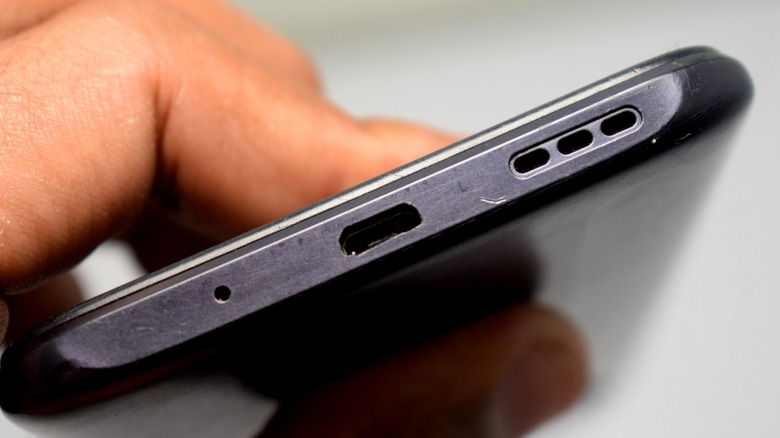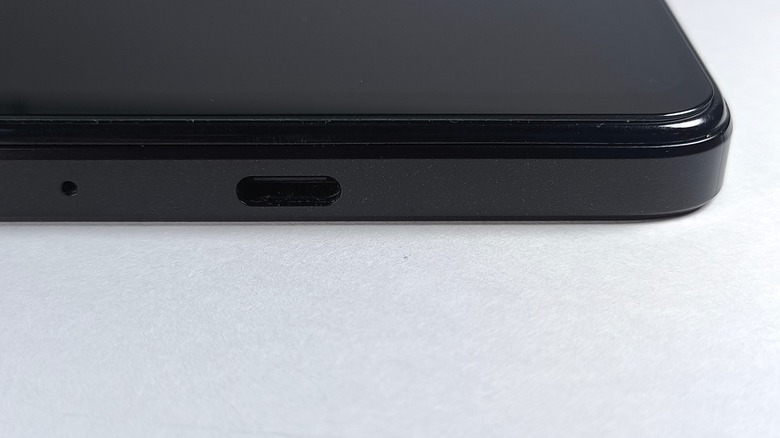Here's Why Your Phone Has A Little Hole Next To The Charging Port
You've probably noticed a tiny pin-sized hole sitting next to your phone's charging port. It's not for cosmetic flair or for venting steam. That tiny hole exists by design, and its role matters a lot more than you think. Some mistake it for the SIM ejection hole. But this is elsewhere and requires a tool or pin. It's also not simply a place to balance out ports or make designs more symmetrical. That hole is a microphone. More specifically, what many call a secondary or auxiliary microphone.
Phones aren't made with just one mic anymore. Alongside the main mic, extra mics pick up ambient sounds. Think wind, background chatter, traffic noise, and so on. These extra mics feed into noise-cancellation software. The idea is that while you speak, the phone uses the main mic to capture your voice. The secondary mic monitors the unwanted background sound. Then, the software subtracts or suppresses the noise picked up by the second mic. So, what people on the other end hear is cleaner, and your voice is clearer.
In mid-range and high-end phones, this arrangement is standard. Even cheaper phones often include at least one extra mic to keep up with user expectations. This is one of the ways cheap Android phones match up to expensive models. Understanding this secondary sound input helps explain why damaging it can degrade your phone over time.
Why manufacturers do it this way and tips to keep it in good shape
Manufacturers place the mic in that spot for various reasons. One reason is because of its proximity to better sound capture. The bottom of the phone tends to be where the speaker and your mouth are during calls. Placing a microphone near the charging port keeps it nearer to your mouth, which helps with capturing your voice more directly. Another is that multiple mics improve performance.
Having more than one mic allows for noise cancellation, stereo, or spatial sound to some extent. It also allows better voice recognition and improved audio in videos. When you record a video, the bottom mic might pick up your voice, while another might capture ambient sound. The software then mixes them to produce a more realistic result. There is also the matter of physical constraints. Smartphones have limited space. The bottom edge, next to the charging port, offers a convenient spot. It is accessible, has fewer obstructions, and allows cable or hand usage without interfering with sound.
To keep the mic in good shape, inspect it regularly for lint, dust, and debris around that hole. Also, check audio performance from time to time. Do this by recording a quick voice memo or video. If the voice sounds distant, muffled, or if background noise overwhelms it, then it could be blocked or damaged. Additionally, ensure your phone case or stand doesn't block that tiny hole. It could be one of the reasons your iPhone microphone isn't working.
Why damaging or misusing that hole cost more than you think
That little opening is delicate. Mistreating it can lead to problems that go beyond muffled sound. In some cases, it can lead to hardware damage. There are several common misuses of the microphone hole. Some people mistake this hole for the SIM-tray eject point. Microphone holes are typically protected from damage from sharp objects, but not if you force something in. Some also use metal or conductive tools while the phone is on. That could short-circuit internal parts, damaging more than just the mic. Even neglecting to clean it could cause damage. Letting dust, lint, or debris build up can block or distort the mic's performance.
To take care of it, you only need to gently clean it. Do this using dry cotton swabs, soft brushes, or gentle air blowers. This is one of the fixes to try if your Android phone's microphone isn't working. Also, avoid sharp or metal implements aimed into that hole. That means no paperclips, pins, or needles. Additionally, use authorized repair when needed. If sound is clearly degraded and cleaning doesn't help, let a professional inspect.
Damage isn't just about sound quality loss. It can affect how people perceive your speech through calls and voice assistants. It can also determine how well videos capture ambient sound, such as the wind and the environment. Damage sometimes leads to hardware repair costs that far exceed what a gentle cleaning tool costs. Furthermore, you may lose features like noise suppression or voice recognition entirely.


